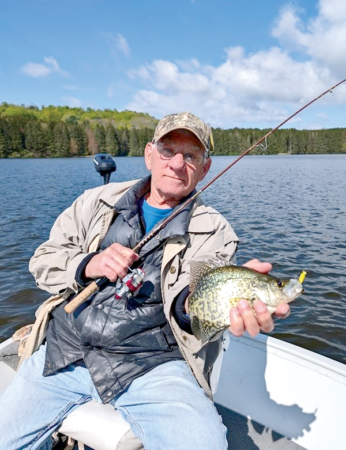When you look at the title of this story, you would think I’m talking about some of the lousy, rainy weather we’ve been dealing with this spring, but I’m actually referring to something positive.
What I’m actually talking about is the outstanding fishing that can be had during the spring days and particularly for black and white crappies.
Crappies spawn in the spring; males move into the shallows around vegetation and rock and wood structures to prepare spawning areas, and the females then move in to lay their eggs. Males will hang around and protect the newborns for a period of time after that.
Now is a great time to target these locations because the males are very protective, and the crappies are very active feeders.
They are often located in shallower waters along shorelines, making fishing opportunities more available even for those who don’t have access to boats.
This is also a great time of the year to introduce someone new to the activity of fishing since the crappies are usually very cooperative, and catching rates are often greater.
Even though the crappies are readily available and often in a very cooperative mood, you still have to use the right equipment, technique, and lure presentations. I’ve mentioned it before, but it’s important to gear down your equipment. Crappies are generally smaller with smaller mouths, and the bite or strike is often a light tap and a light line in the 2–4-pound range is better.
I’ve even gone to braided line, which has no stretch and telegraphs those light strikes much better. Also, fluorocarbon, which has little stretch, will make it easier to detect those light taps from crappies.
Sure, I’ve seen people catching crappies and other panfish with their heavier bass fishing gear, but I’m a firm believer that gearing down that equipment for panfish will greatly increase your catching rate.
Over the past few weeks, I’ve been out crappie fishing on three different lakes in our general area, and I have had good success on each lake. Last week my wife and I were out working a cove on a lake that had a wood structure where the crappies were no doubt beginning to move into, but we actually did better in the slightly deeper water of 6-8 feet working our lures near the bottom.
There is no question that hooking a small, live minnow on several feet below a bobber would be a very effective presentation, but I seldom ever use live minnows — they cost too much, and they are more trouble to transport and keep alive.
Artificial baits are my choice; they are easy to transport and store, are equally effective, and seldom need to be replaced.
Occasionally, I will utilize a slip bobber if I target a school of fish somewhere mid-depth or just off the bottom. The slip bobber can easily be set to the desired depth, and following cast, the slip bobber moves up to the preset depth on your line.
As for artificial lures, keep them small as well, one to two inches in a soft plastic or even yarns and feather combinations. I mostly use a one-eighth or one-sixteenth jig and slide my plastic grub onto that.
A lot of colors seem to produce but some of our favorites are white, brown, and chartreuse, but there are times when yellow, orange, black, and other colors and combinations of colors have also produced. I generally use the brighter colors in off-colored water and the more natural colors in clearer water.
It’s very important to keep a tight line if you’re fishing without a bobber to detect strikes. Slack line laying on the water results in a lot of missed strikes.
Well, now that I’ve managed to get all the grass cut between rainfalls, maybe I can take some of my own advice and get back out onto a lake for some great crappie fishing.




